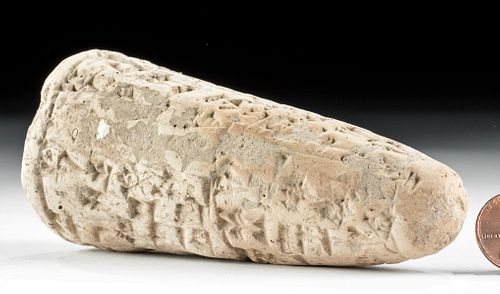Translated Sumerian Clay Foundation Cone - Ishme Dagan
Lot 69b
About Seller
Artemis Gallery
686 S Taylor Ave, Ste 106
Louisville, CO 80027
United States
Selling antiquities, ancient and ethnographic art online since 1993, Artemis Gallery specializes in Classical Antiquities (Egyptian, Greek, Roman, Near Eastern), Asian, Pre-Columbian, African / Tribal / Oceanographic art. Our extensive inventory includes pottery, stone, metal, wood, glass and textil...Read more
Categories
Estimate:
$2,000 - $3,000
Absentee vs Live bid
Two ways to bid:
- Leave a max absentee bid and the platform will bid on your behalf up to your maximum bid during the live auction.
- Bid live during the auction and your bids will be submitted real-time to the auctioneer.
Bid Increments
| Price | Bid Increment |
|---|---|
| $0 | $25 |
| $300 | $50 |
| $1,000 | $100 |
| $2,000 | $250 |
| $5,000 | $500 |
| $10,000 | $1,000 |
| $20,000 | $2,500 |
| $50,000 | $5,000 |
| $100,000 | $10,000 |
| $200,000 | $20,000 |
About Auction
By Artemis Gallery
Feb 13, 2020
Set Reminder
2020-02-13 10:00:00
2020-02-13 10:00:00
America/New_York
Bidsquare
Bidsquare : Exceptional Antiquities, Asian, Ethnographic
https://www.bidsquare.com/auctions/artemis-gallery/exceptional-antiquities-asian-ethnographic-4848
An important one-day auction featuring museum-worthy examples of Egyptian, Greek, Roman, Etruscan, Near Eastern, Far East / Asian, Pre-Columbian, African / Tribal, Oceanic, Native American, Spanish Colonial, Russian, Fossils, Ancient Jewelry, Fine Art, so much more! Artemis Gallery info@artemisgallery.com
An important one-day auction featuring museum-worthy examples of Egyptian, Greek, Roman, Etruscan, Near Eastern, Far East / Asian, Pre-Columbian, African / Tribal, Oceanic, Native American, Spanish Colonial, Russian, Fossils, Ancient Jewelry, Fine Art, so much more! Artemis Gallery info@artemisgallery.com
- Lot Description
Ancient Near East, Sumer, reign of Ishme-Dagan of Isin, ca. 1953 to 1935 BCE. A hand-built clay foundation cone with a tapered conical body, a rounded tip, and a flat head. The smooth surfaces of the cone are inscribed with fourteen lines - seven on top and seven below - that are formed by impressing a sharpened reed or stick into the still-wet clay just before undergoing the firing process. When translated this cone reads, "Ishme-Dagan, mighty man, King of Isin, King of the Four Quarters (of the world) when he exempted the tribute obligations of Nippur, the city beloved by Enlil, and took its populace away from forced labor, he built the wall of Isin, naming it 'Ishme-Dagan,' with Enlil, the might of the great god.'" Size: 4" L x 1.75" W (10.2 cm x 4.4 cm)
Clay nails like this are also referred to as dedication pegs or funerary pegs; they were inscribed, baked, and stuck into walls made of mud-brick to mark ownership either by a god or a ruler. These dedications sometimes include stories or boasts about the rulers they describe, and are some of our earliest sources of written royal history.
Cuneiform script is one of the oldest known writing systems in the world, made using a reed as a stylus and scratching wedge-shaped marks onto clay tablets. Early cuneiform was pictographic, but in the 3rd millennium BCE it shifted to the more abstract form you see here. These cuneiform objects are some of the roughly 2 million known from this culture; of these, between 30,000 and 100,000 have been translated. The earliest translations came in 1836 from the work of French scholar Eugene Burnouf and by the 1850s multiple scholars were able to produce similar translations, meaning the language had been deciphered.
Translation from: George, A.R. "Bibliotheca Orientalis 53." 1996, no. 366; also from: George, A.R. "Cuneiform Royal Inscriptions and Related Texts in the Schoyen Collection." CDL Press, Bethesda, Maryland, 2011, p. 91, no. 39
Provenance: private New York, New York, USA collection; ex-private New York, USA collection, acquired in 2000s from Time Machine, New York, USA
All items legal to buy/sell under U.S. Statute covering cultural patrimony Code 2600, CHAPTER 14, and are guaranteed to be as described or your money back.
A Certificate of Authenticity will accompany all winning bids.
We ship worldwide and handle all shipping in-house for your convenience.
#153104Minor nicks and abrasions to ends and body, with softening and encrustations to some cuneiform characters, otherwise intact and excellent. Nice earthen deposits throughout. Most cuneiform characters are still legible.Condition
- Shipping Info
-
All shipping is handled in-house for your convenience. Your invoice from Artemis Gallery will include shipping calculation instructions. If in doubt, please inquire BEFORE bidding for estimated shipping costs for individual items.
-
- Buyer's Premium



 EUR
EUR CAD
CAD AUD
AUD GBP
GBP MXN
MXN HKD
HKD CNY
CNY MYR
MYR SEK
SEK SGD
SGD CHF
CHF THB
THB














